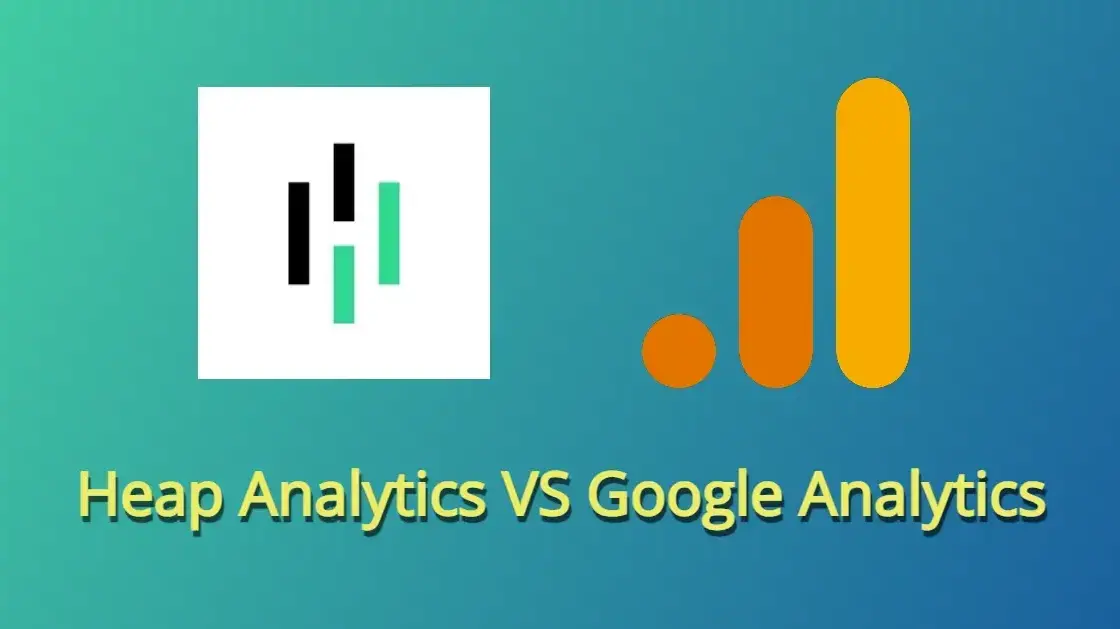If you’ve been wondering if there’s anything better than Google Analytics, you might be considering Heap Analytics. Both analytic tools offer a lot for your marketing needs. In this article, you’ll see Heap Analytics vs Google Analytics, and be able to decide for yourself what suits your needs.
What is Heap Analytics?
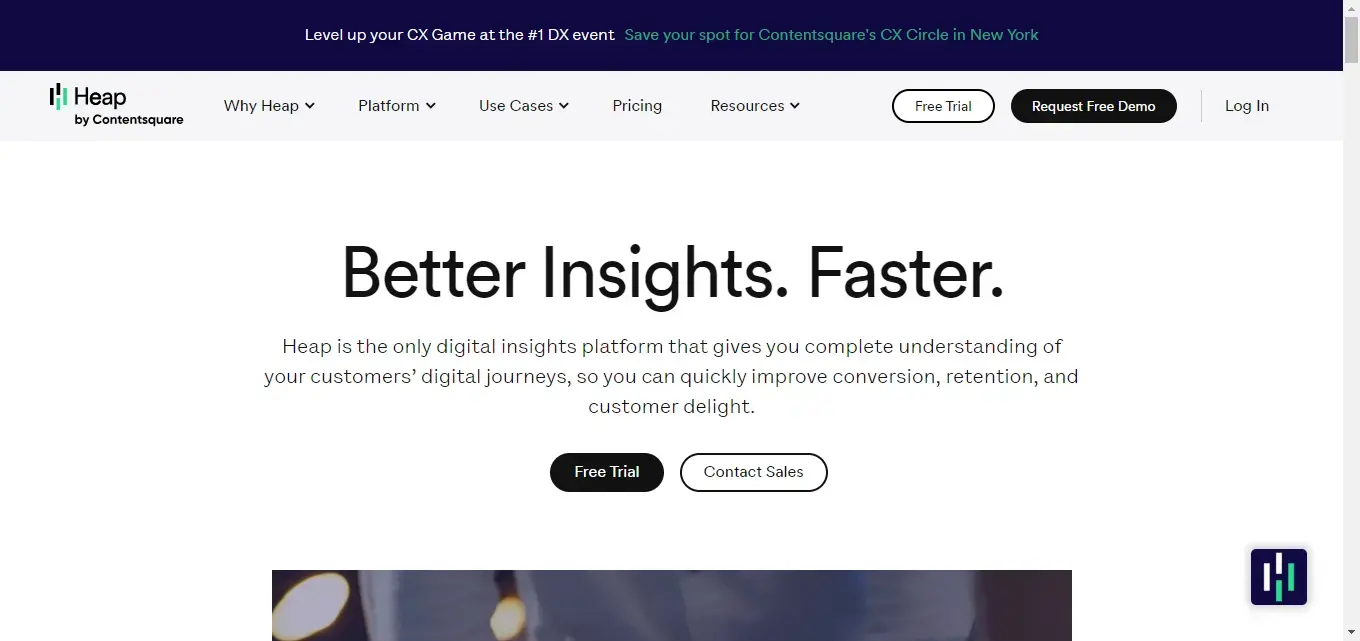
Heap Analytics is a data analytics tool that helps businesses track and analyze user behavior on their websites or apps.
Unlike traditional analytics tools that require manual event tracking, Heap automatically captures every user interaction, such as clicks, page views, and form submissions. This approach allows businesses to analyze user behavior in detail without needing to predefine specific events to track.
Key features of Heap include:
Automatic Data Collection
Event Creation and Analysis
User Segmentation
Funnels and Conversion Tracking
Custom Dashboards and Reports
Automatic Data Collection
Heap captures all user interactions automatically, which means you don’t need to set up tracking for individual events manually.
Event Creation and Analysis
You can define and analyze events retroactively, which helps in understanding user behavior and making data-driven decisions even if the events weren’t originally planned.
User Segmentation
Heap allows you to segment users based on their behavior, demographics, or other criteria to gain insights into different user groups.
Funnels and Conversion Tracking
You can create funnels to track user journeys and conversion rates, helping to identify where users drop off in a process.
Custom Dashboards and Reports
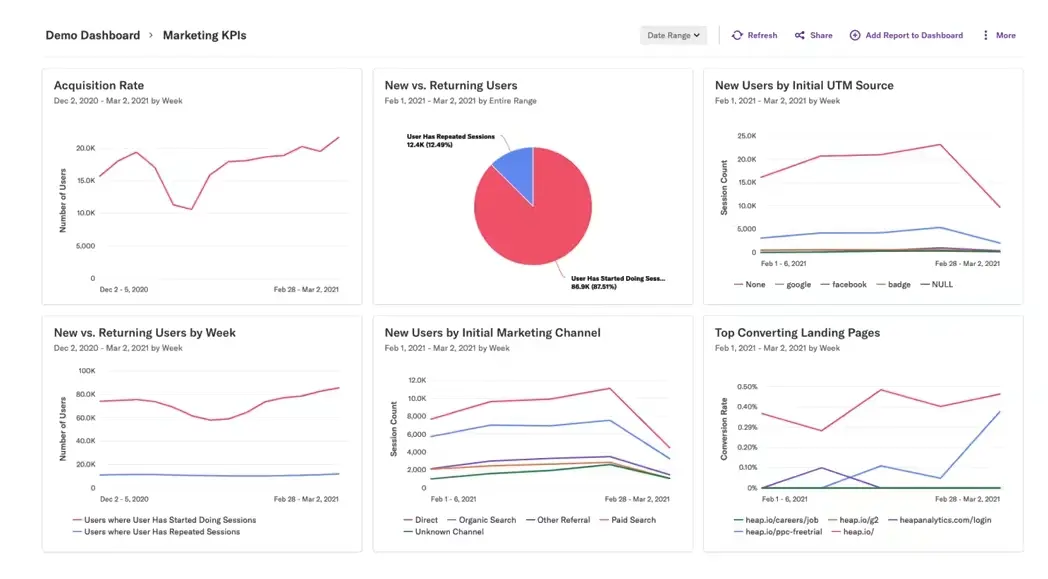
Heap provides customizable dashboards and reports to visualize and interpret your data in a way that meets your business needs.
What is Google Analytics?
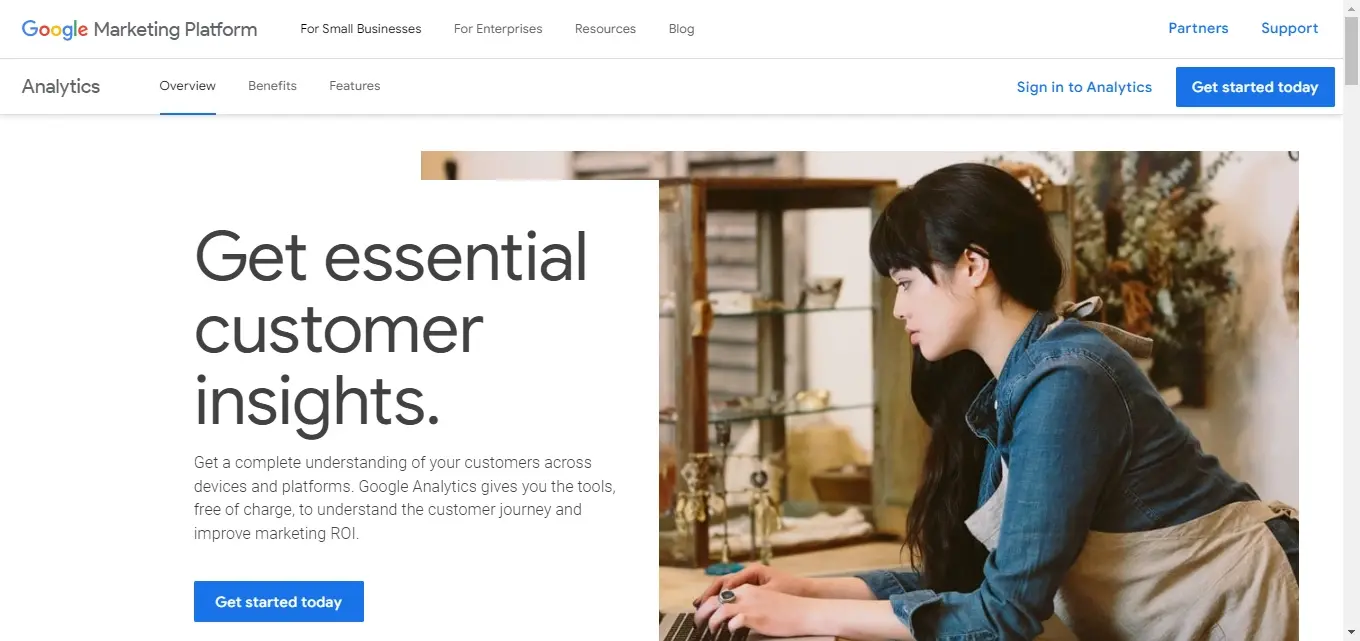
Google Analytics is a web analytics service offered by Google that tracks and reports website traffic and user behavior.
It's widely used by businesses and website owners to understand how users interact with their sites and apps.
Key features and functionalities of Google Analytics include:
Traffic Analysis
Audience Insights
Behavior Tracking
Conversion Tracking
Real-Time Data
Customizable Reports and Dashboards
Integration with Google Ads
Traffic Analysis
Google Analytics provides detailed reports on website traffic, including metrics such as pageviews, unique visitors, session duration, and bounce rate. This helps users understand how many people are visiting their site and how they are engaging with it.
Audience Insights
It offers insights into the demographics, interests, and geographic locations of your website visitors. This information helps in understanding your audience better and tailoring content or marketing strategies accordingly.
Behavior Tracking
Google Analytics tracks user behavior on your site, including which pages they visit, how they navigate through the site, and where they drop off. This helps in identifying user interests and optimizing user experience.
Conversion Tracking
The platform allows you to set up and track conversion goals, such as completed purchases, form submissions, or other desired actions. This helps measure the effectiveness of marketing campaigns and website performance.
Real-Time Data
Google Analytics provides real-time data on active users, current traffic sources, and user interactions. This allows you to monitor and respond to changes as they happen.
Customizable Reports and Dashboards
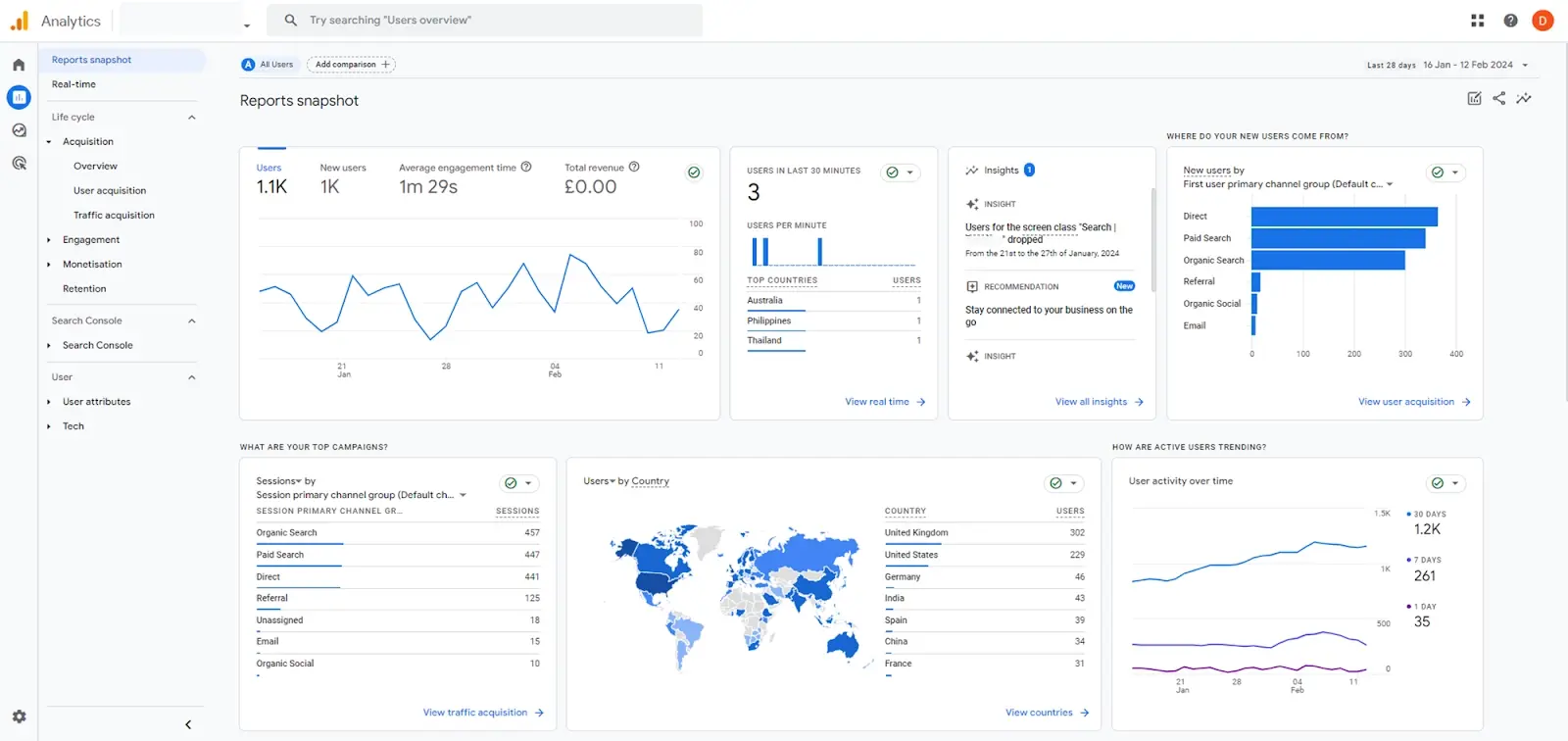
You can create custom reports and dashboards to focus on specific metrics or dimensions relevant to your business goals. This flexibility helps in analyzing data in ways that are most useful for your needs.
Integration with Google Ads
Google Analytics integrates with Google Ads, enabling you to track the performance of your advertising campaigns and understand how they contribute to your website traffic and conversions.
Heap Analytics vs Google Analytics
Choosing between Heap Analytics and Google Analytics depends on your specific needs and preferences. Here’s a summary of the strengths and downfalls of each:
Heap Analytics
Pros and Cons of Heap Analytics
Pros
Cons
Pros of Heap Analytics
Here are five pros of using Heap Analytics:
Automatic Data Capture
Heap automatically tracks all user interactions, such as clicks, page views, and form submissions, without needing manual event setup. This reduces the time and effort required to implement tracking and ensures that no interactions are missed.
Flexible Event Analysis
Because Heap captures all data, you can define and analyze events retroactively. This means you can adjust your analysis as new insights or questions arise without having to re-implement tracking code.
Comprehensive User Insights
Heap's ability to track and analyze every user action allows for in-depth understanding of user behavior. This includes identifying user journeys, segmenting users based on their actions, and uncovering patterns that might not be visible with more traditional analytics tools.
Easy Funnel and Conversion Tracking
Heap simplifies the creation of funnels and tracking conversion rates. You can easily visualize and analyze the user journey through different stages, helping to identify where users drop off and where improvements can be made.
Customizable Dashboards and Reports
Heap offers robust tools for creating custom dashboards and reports, allowing you to visualize your data in ways that are most relevant to your business goals. This customization helps in making data-driven decisions and communicating insights effectively to stakeholders.
Cons of Heap Analytics
Here are five potential cons of using Heap Analytics:
Complexity for New Users
Despite its powerful features, Heap can be complex for new users to navigate, especially those unfamiliar with data analytics or event tracking concepts. The learning curve can be steep, requiring time to fully understand and utilize the platform's capabilities.
Data Volume Management
Since Heap captures all interactions, the volume of data can become overwhelming. Managing and making sense of large amounts of data can be challenging, and without proper organization, it may be difficult to extract meaningful insights.
Cost Considerations
Heap's pricing can be on the higher side, particularly for small businesses or startups. The cost might increase significantly as your data volume or user base grows, potentially making it less cost-effective for some organizations.
Performance Issues
Some users report performance issues or delays in data processing, especially with large datasets or complex queries. This can affect the timeliness of insights and the overall user experience.
Limited Integrations
While Heap integrates with many tools, it may not support all the integrations you need. Depending on your tech stack, you might encounter limitations in connecting Heap with other systems or tools your organization uses.
Google Analytics
Pros and Cons of Google Analytics
Pros
Cons
Pros of Google Analytics
Here are five reasons to use Google Analytics:
Comprehensive Data Tracking
Google Analytics provides detailed insights into user behavior, traffic sources, and engagement metrics. This comprehensive data helps businesses understand how visitors interact with their site, which pages are most popular, and where improvements are needed.
Cost-Effective
Google Analytics offers a robust set of features for free, making it an accessible option for businesses of all sizes. There is also a premium version, Google Analytics 360, for larger enterprises that require advanced features and support.
Integration with Google Ads and Other Tools
Google Analytics integrates seamlessly with Google Ads and other Google marketing tools, allowing for unified tracking and reporting. This integration helps in analyzing the performance of advertising campaigns and optimizing marketing strategies.
Customizable Reports and Dashboards
The platform allows you to create custom reports and dashboards tailored to your specific business needs. This flexibility enables you to focus on the metrics that matter most and present data in a way that aligns with your goals.
Real-Time Insights
Google Analytics provides real-time data on user activity, including current traffic, active users, and real-time interactions. This immediate feedback helps in monitoring live campaigns, reacting quickly to changes, and making timely adjustments to your strategies.
Cons of Google Analytics
Here are five reasons why some might choose not to use Google Analytics:
Privacy Concerns
Google Analytics collects a significant amount of user data, which may raise privacy concerns for both businesses and users. With increasing regulations like GDPR and CCPA, managing user data responsibly can be challenging, and some businesses may prefer tools that offer more robust privacy controls.
Data Sampling Limitations
For large datasets, Google Analytics often uses data sampling to generate reports, which can lead to less precise insights. This can be a drawback if you need highly accurate data for making decisions.
Complexity for Beginners
Google Analytics can be complex and overwhelming, especially for those new to analytics. Setting up tracking, creating custom reports, and interpreting data may require a steep learning curve and a significant investment of time.
Performance Issues with Large Data Sets
With very high traffic volumes or complex queries, Google Analytics might experience performance issues or delays in data processing. This can affect the timeliness of reporting and the ability to make real-time decisions.
Limited Features in the Free Version
While the free version of Google Analytics is powerful, it lacks some advanced features available in the premium version, Google Analytics 360. For organizations that require advanced analytics, more detailed customer support, or higher data limits, the free version may not suffice.
In Summary
In the battle of Heap Analytics vs Google Analytics, Heap Analytics might be better if you need automatic, retroactive event tracking, and deep behavioral insights with less manual configuration. It's particularly useful if you're looking for flexibility in analyzing user interactions and have the budget for it.
As for Google Analytics, it could be the preferred choice if you want a widely used tool with comprehensive features at a lower cost, especially if you’re already using other Google products. It’s well-suited for detailed traffic analysis, audience insights, and integrating with marketing tools.
Hopefully this article will help you make a choice on which analytics tool will be more useful for you.
Frequently Asked Questions
How can Google Analytics help me enhance my landing page's effectiveness?
Google Analytics provides insights into visitor behavior, allowing you to track metrics like traffic sources, bounce rates, and conversion rates. This helps you optimize your landing page for better performance.
How do analytics from push notifications integrate with overall website analytics?
Integration involves tracking push notification performance alongside website analytics. Connecting data provides a holistic view of user interactions, helping refine strategies and align marketing efforts.
Does Google offer free website hosting?
Yes, Google offers free website hosting through Google Sites, which allows you to create and publish a basic website without any cost. However, it is limited in features compared to paid hosting services.

Nile Flores is a long time professional blogger, as well as WordPress website designer and developer from the St. Louis Metro East. Nile blogs at NileFlores.com, where she’s passionate about helping website owners, whether they’re small business owners or bloggers. She teaches about Blogging, Social Media, Search Engine Optimization, Website Design, and WordPress. Additionally, Nile loves to speak at WordCamps (WordPress conferences) across the United States. When Nile isn’t knee-deep in coding, she’s a proud mom of a college student, and enjoys oil painting, cigar smoking, nail art design, and practicing traditional Okinawan kempo karate.
View all posts by Nile Flores















